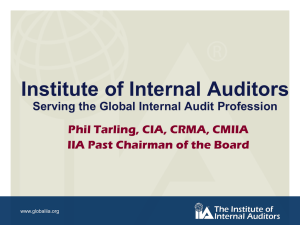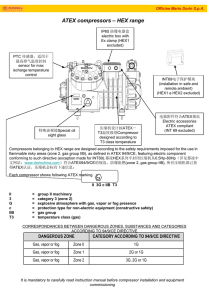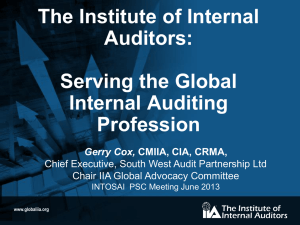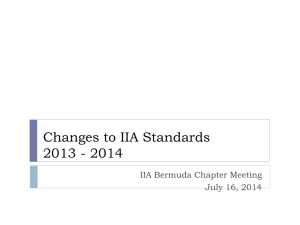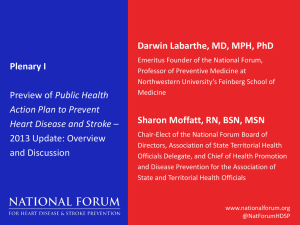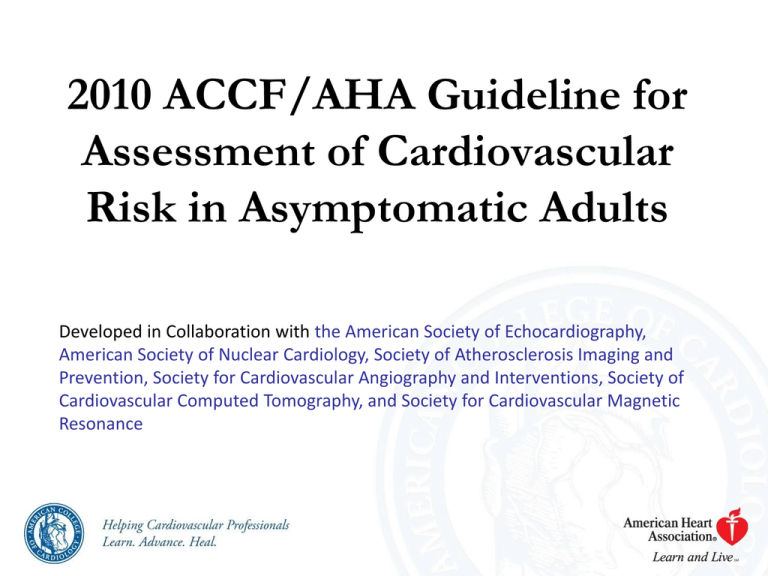
2010 ACCF/AHA Guideline for
Assessment of Cardiovascular
Risk in Asymptomatic Adults
Developed in Collaboration with the American Society of Echocardiography,
American Society of Nuclear Cardiology, Society of Atherosclerosis Imaging and
Prevention, Society for Cardiovascular Angiography and Interventions, Society of
Cardiovascular Computed Tomography, and Society for Cardiovascular Magnetic
Resonance
Citation
This slide set was adapted from the 2010 ACCF/AHA
Guideline for Assessment of Cardiovascular Risk in
Asymptomatic Adults (Journal of the American College
of Cardiology). Published ahead of print on November
15, 2010, available at:
http://content.onlinejacc.org/cgi/content/full/j.jacc.2010.
09.001
The full-text guidelines are also available on the following Web
sites:
ACC (www.cardiosource.org) and,
AHA (www.americanheart.org)
Special Thanks To
Slide Set Editors
Nanette K. Wenger, MD and Philip Greenland, MD
The Guideline for CV Risk Assessment in Asymptomatic
Adults Writing Committee Members
Philip Greenland, MD, FACC, FAHA, Chair
Frederick G. Kushner, MD, FACC, FAHA†‡‡
Joseph S. Alpert, MD, FACC, FAHA
Michael S. Lauer, MD, FACC, FAHA
George A. Beller, MD, MACC, FAHA
Leslee J. Shaw, PhD, FACC, FAHA, FASNC§§
Emelia J. Benjamin, MD, ScM, FACC, FAHA*†
Sidney C. Smith, Jr., MD, FACC, FAHA║║¶¶
Matthew J. Budoff, MD, FACC, FAHA‡§║
Allen J. Taylor, MD, FACC, FAHA##
Zahi A. Fayad, PhD, FACC, FAHA¶
William S. Weintraub, MD, FACC, FAHA
Elyse Foster, MD, FACC, FAHA#
Nanette K. Wenger, MD, MACC, FAHA
Mark A. Hlatky, MD, FACC, FAHA§**
John McB. Hodgson, MD, FACC, FAHA, FSCAI‡§**††
*ACCF/AHA Task Force on Performance Measures Liaison; †Recused from Section 2.4.5., Lipoprotein-Associated Phospholipase A2; ‡ Recused from
Section 2.5.11., Coronary Computed Tomography Angiography; §Recused from Section 2.6.1., Diabetes Mellitus; ║SAIP Representative; ¶SCMR
Representative; #ASE Representative; **Recused from Section 2.5.10., Computed Tomography for Coronary Calcium; †† SCAI Representative;
‡‡Recused from Section 2.3., Lipoprotein and Apolipoprotein Assessments; §§ASNC Representative; ║║ACCF/AHA Task Force on Practice
Guidelines Liaison; ¶¶Recused from Section 2.4.2., Recommendations for Measurement of C-Reactive Protein; ##SCCT Representative.
Classification of Recommendations and Levels of Evidence
*Data available from clinical trials or registries about the usefulness/efficacy in different subpopulations, such as gender, age, history of diabetes, history of prior myocardial infarction, history of heart failure, and prior aspirin use. A
recommendation with Level of Evidence B or C does not imply that the recommendation is weak. Many important clinical questions addressed in the guidelines do not lend themselves to clinical trials. Even though randomized trials are not
available, there may be a very clear clinical consensus that a particular test or therapy is useful or effective.
†For comparative effectiveness recommendations (Class I and IIa; Level of Evidence A and B only), studies that support the use of comparator verbs should involve direct comparisons of the treatments or strategies being evaluated.
Icons representing the Classification and
Evidence Levels for Recommendations
I IIa IIb III
I IIa IIb III
I IIa IIb III
I IIa IIb III
I IIa IIb III
I IIa IIb III
I IIa IIb III
I IIa IIb III
I IIa IIb III
I IIa IIb III
I IIa IIb III
I IIa IIb III
Key Considerations when Testing for
CV Risk
• Efficacy of test procedure in assignment of risk status
• Short-term risk
• Long-term risk
• Independent statistical association with risk beyond traditional
readily available inexpensive risk markers
• Incremental predictive value of test
• Effect on reclassification of risk compared to traditional risk
factors alone
• Accuracy and reproducibility of test
• Requirement for serial testing, which may be indicated to
assess risk accurately for some tests
2010 ACCF/AHA Guideline, JACC 55:e27, 2010
Key Considerations when Testing for CV
Risk (continued)
Effect on performance of added testing
• Noninvasive, invasive
• Post-test referral bias
Effect on initiation of interventions
• Lifestyle
• Pharmacologic
Effect on outcomes
• Short-term
• Long-term
Effect on individual undergoing testing
• Financial
• Emotional
Cost of test or procedure
• Financial
• Test risks
Opportunity for Early Preventive
Interventions
• Long asymptomatic latent period of Coronary Heart
Disease (CHD)
• Half of all cardiovascular sudden death not preceded by
cardiac symptoms, diagnoses
• High prevalence of atherosclerotic risk factors in US
population
• Methodology available to evaluate prognostic value of risk
factors, risk markers
• Target intensity of intervention to severity of risk
• Lower the high burden of coronary death in asymptomatic
adults
Guideline for Cardiovascular Risk
Assessment in Asymptomatic Adults
Recommended Approaches to
Risk Stratification
Recommended Approaches to Risk
Stratification
General Approaches to Risk
Stratification
Recommendations for General
Approaches to Risk Stratification
I IIa IIb III
Global risk scores (such as the Framingham Risk
Score [FRS]) that use multiple traditional
cardiovascular risk factors should be obtained for
risk assessment in all asymptomatic adults
without a clinical history of CHD. These scores
are useful for combining individual risk factor
measurements into a single quantitative estimate
of risk that can be used to target preventive
interventions.
Comparison of a Sample of Global Coronary
and Cardiovascular Risk Scores
Framingham
SCORE
PROCAM (Men)
Reynolds (Women)
Reynolds (Men)
Sample size
5345
205,178
5389
24,558
10,724
Age, range (y)
30 to 74; M:49
19 to 80; M:46
35 to 65; M:47
>45; M:52
>50; M:63
Mean follow-up (y)
12
13
10
10.2
10.8
Risk factors
considered
Age, sex, total
cholesterol, HDL
cholesterol,
smoking, systolic
blood pressure,
antihypertensive
Medications
Age, sex, totalHDL cholesterol
ratio, smoking,
systolic blood
pressure
Age, LDL
cholesterol, HDL
cholesterol,
smoking, systolic
blood pressure,
family history,
diabetes,
triglycerides
Age, HbA1C (with
diabetes), smoking,
systolic blood pressure,
total cholesterol, HDL
cholesterol, hsCRP,
parental history of MI
at <60 y of age
Age, systolic blood
pressure, total
cholesterol, HDL
cholesterol, smoking,
hsCRP, parental history
of MI at <60 y of age
Endpoints
CHD (MI and
CHD death)
Fatal CHD
Fatal/nonfatal
MI or sudden
cardiac death
(CHD and CVD
combined)
MI, ischemic stroke,
coronary
revascularization,
cardiovascular death
(CHD and CVD
combined)
MI, stroke, coronary
revascularization,
cardiovascular death
(CHD and CVD
combined)
URLs for risk
calculators
http://hp2010.nhlbi
hin.net/atpiii/calcul
ator.asp?usertype=
prof
http://www.heartsc
ore.org/pages/welc
ome.aspx
http://www.chdtaskforce.com/co
ronary_risk_asse
ssment.html
http://www.reynoldsris
kscore.org/
http://www.reynoldsris
kscore.org/
Note: Table 2 in full-text Guideline
Recommended Approaches to Risk
Stratification
Family History and Genomics
Recommendations for Family
History and Genomic Testing
I IIa IIb III
Family history of atherothrombotic cardiovascular
disease (CVD) should be obtained for
cardiovascular risk assessment in all
asymptomatic adults.
I IIa IIb III
Genotype testing for CHD risk assessment in
asymptomatic adults is not recommended.
Recommended Approaches to Risk
Stratification
Lipoprotein and Apolipoprotein
Assessments
Recommendation for Lipoprotein
and Apolipoprotein Assessments
I IIa IIb III
Measurement of lipid parameters, including
lipoproteins, apolipoproteins, particle size, and
density, beyond a standard fasting lipid profile is
not recommended for cardiovascular risk
assessment in asymptomatic adults.
Recommended Approaches to Risk
Stratification
Other Circulating Blood
Markers and Associated
Conditions
Recommendation for Natriuretic
Peptides
I IIa IIb III
Measurement of natriuretic peptides is not
recommended for CHD risk assessment in
asymptomatic adults.
Recommendations for Measurement
of C-Reactive Protein (CRP)
I IIa IIb III
In men 50 years of age or older or women 60
years of age or older with LDL cholesterol less
than 130 mg/dL; not on lipid-lowering, hormone
replacement, or immunosuppressant therapy;
without clinical CHD, diabetes, chronic kidney
disease, severe inflammatory conditions, or
contraindications to statins, measurement of
CRP can be useful in the selection of patients
for statin therapy.
Recommendations for Measurement
of C-Reactive Protein (continued)
I IIa IIb III
In asymptomatic intermediate-risk men 50 years
of age or younger or women 60 years of age or
younger, measurement of CRP may be
reasonable for cardiovascular risk assessment.
I IIa IIb III
In asymptomatic high-risk adults, measurement
of CRP is not recommended for cardiovascular
risk assessment.
I IIa IIb III
In low-risk men younger than 50 years of age or
women 60 years of age or younger,
measurement of CRP is not recommended for
cardiovascular risk assessment.
Recommendation for Measurement
of Hemoglobin A1C
I IIa IIb III
Measurement of hemoglobin A1C (HbA1C)
may be reasonable for cardiovascular risk
assessment in asymptomatic adults without
a diagnosis of diabetes.
Recommendations on testing for
Microalbuminuria
(Urinary Albumin Excretion)
I IIa IIb III
In asymptomatic adults with hypertension or
diabetes, urinalysis to detect microalbuminuria
is reasonable for cardiovascular risk
assessment.
I IIa IIb III
In asymptomatic adults at intermediate risk
without hypertension or diabetes, urinalysis to
detect microalbuminuria might be reasonable for
cardiovascular risk assessment.
Recommendation for Lipoproteinassociated Phospholipase A2
I IIa IIb III
Lipoprotein-associated phospholipase A2 (LpPLA2) might be reasonable for cardiovascular
risk assessment in intermediate-risk
asymptomatic adults.
Recommended Approaches to Risk
Stratification
Cardiac and Vascular Tests for
Risk Assessment in
Asymptomatic Adults
Recommendations for Resting
Electrocardiogram
I IIa IIb III
A resting electrocardiogram (ECG) is
reasonable for cardiovascular risk assessment
in asymptomatic adults with hypertension or
diabetes.
I IIa IIb III
A resting ECG may be considered for
cardiovascular risk assessment in
asymptomatic adults without hypertension or
diabetes.
Recommendation for Transthoracic
Echocardiogram
I IIa IIb III
Echocardiography to detect left ventricular
hypertrophy may be considered for
cardiovascular risk assessment in asymptomatic
adults with hypertension.
I IIa IIb III
Echocardiography is not recommended for
cardiovascular risk assessment of CHD in
asymptomatic adults without hypertension.
Recommendation for Measurement of
Carotid Intima-Media Thickness
I IIa IIb III
Measurement of carotid artery intima-media
thickness is reasonable for cardiovascular risk
assessment in asymptomatic adults at
intermediate risk. Published recommendations
on required equipment, technical approach, and
operator training and experience for
performance of the test must be carefully
followed to achieve high-quality results.
Recommendation for Brachial /
Peripheral Flow-mediated Dilation
I IIa IIb III
Peripheral arterial flow-mediated dilation studies
are not recommended for cardiovascular risk
assessment in asymptomatic adults.
Recommendation for Specific
Measures of Arterial Stiffness
I IIa IIb III
Measures of arterial stiffness outside of
research settings are not recommended for
cardiovascular risk assessment in asymptomatic
adults.
Recommendation for Measurement of
Ankle-Brachial Index
I IIa IIb III
Measurement of ankle-brachial index is
reasonable for cardiovascular risk
assessment in asymptomatic adults at
intermediate risk.
Recommendation for Exercise
Electrocardiography
I IIa IIb III
An exercise ECG may be considered for
cardiovascular risk assessment in intermediaterisk asymptomatic adults (including sedentary
adults considering starting a vigorous exercise
program), particularly when attention is paid to
non-ECG markers such as exercise capacity.
Recommendation for Stress
Echocardiography
I IIa IIb III
Stress echocardiography is not indicated for
cardiovascular risk assessment in low- or
intermediate-risk asymptomatic adults. (Exercise
or pharmacological stress echocardiography is
primarily used for its role in advanced cardiac
evaluation of symptoms suspected of
representing CHD and/or estimation of prognosis
in patients with known CAD or the assessment of
subjects with valvular heart disease.)
Recommendations for Myocardial
Perfusion Imaging
I IIa IIb III
Stress MPI may be considered for advanced
cardiovascular risk assessment in asymptomatic adults
with diabetes or asymptomatic adults with a strong family
history of CHD or when previous risk assessment testing
suggests high risk of CHD, such as a coronary artery
calcium (CAC) score of 400 or greater.
I IIa IIb III
Stress MPI is not indicated for cardiovascular risk
assessment in low- or intermediate-risk asymptomatic
adults. (Exercise or pharmacologic stress MPI is a
technology primarily used and studied for its role in
advanced cardiac evaluation of symptoms suspected of
representing CHD and/or estimation of prognosis in
patients with known coronary artery disease.)
Recommendations for Calcium Scoring
Methods
I IIa IIb III
Measurement of CAC is reasonable for
cardiovascular risk assessment in asymptomatic
adults at intermediate risk (10% to 20% 10-year
risk.
I IIa IIb III
Measurement of CAC may be reasonable for
cardiovascular risk assessment persons at low
to intermediate risk (6% to 10% 10-year risk).
I IIa IIb III
Persons at low risk (<6% 10-year risk) should
not undergo CAC measurement for
cardiovascular risk assessment.
Recommendation for Coronary
Computed Tomography Angiography
I IIa IIb III
Coronary computed tomography angiography is
not recommended for cardiovascular risk
assessment in asymptomatic adults.
Recommendation for Magnetic
Resonance Imaging of Plaque
I IIa IIb III
Magnetic resonance imaging for detection of
vascular plaque is not recommended for
cardiovascular risk assessment in asymptomatic
adults.
Recommended Approaches to Risk
Stratification
Special Circumstances and
Other Considerations
Risk Assessment Considerations for
Patients with Diabetes Mellitus
I IIa IIb III
In asymptomatic adults with diabetes, 40 years of
age and older, measurement of CAC is reasonable
for cardiovascular risk assessment.
I IIa IIb III
Measurement of hemoglobin A1C may be considered
for cardiovascular risk assessment in asymptomatic
adults with diabetes.
I IIa IIb III
Stress MPI may be considered for advanced
cardiovascular risk assessment in asymptomatic
adults with diabetes or when previous risk
assessment testing suggests high risk of CHD, such
as a CAC score of 400 or greater.
Risk Assessment Considerations for
Women
There is frequent reporting of underutilization of diagnostic and
preventive services among female patients. Therefore, it is
recommended that:
I IIa IIb III
A global risk score should be obtained in all
asymptomatic women.
I IIa IIb III
Family history of CVD should be obtained for
cardiovascular risk assessment in all
asymptomatic women.
Guideline for Cardiovascular Risk
Assessment in Asymptomatic Adults
Summary of Tests Not
Recommended for Assessing
CV Risk in Asymptomatic
Adults
Procedural Tests Not Recommended
for Asymptomatic Adults
- Non-cardiac tests -
• Genotype testing (III B)
• Lipid parameters including lipoproteins, apolipoproteins, particle size
and density assessments beyond standard fasting lipid profile (III C)
• Natriuretic peptide measurement (III B)
• C-Reactive Protein measurement in asymptomatic high-risk adults
(III B)
• CRP in low-risk men younger than 50 years of age or women 60
years of age (III B)
Procedural Tests Not Recommended
for Asymptomatic Adults (continued)
- Cardiac or Vascular tests -
• Transthoracic echocardiogram for asymptomatic adults without
hypertension (III C)
• Brachial/peripheral arterial flow mediated dilation studies (III B)
• Measures of arterial stiffness outside of research settings (III C)
• Stress echocardiography in low- or intermediate-risk adults (III C)
• Stress myocardial perfusion imaging in low- or intermediate-risk adults
(III C)
• Coronary artery calcium scoring in low risk adults (<6% 10 year risk) (III B)
• Coronary computed tomography angiography (CCTA) (III C)
• Detection of coronary artery plaque by magnetic resonance imaging (III C)
Limited Data
Role of novel biomarkers/imaging studies in risk
assessment of selected populations – asymptomatic
adults
Selected populations
•
•
•
•
•
•
Women
Older adults
Racial and ethnic minorities
Diabetes
Chronic kidney disease
Geographic, environmental, neighborhood risk
Unmet Needs
Ascertainment among tests of value
• Whether test/procedure useful to motivate
patients to adhere to recommended interventions
• Whether test/procedure useful to guide therapy
• Whether test/procedure useful as a repeat
measure to monitor effects of therapy
• Whether test/procedure of value in improving
health outcomes
Risk Assessment: Clinical
Implications
Designed to aid clinician in informed decision-making
about lifestyle and pharmacologic interventions to
reduce CV risk
Patients broadly characterized into low-, intermediateand high-risk subsets
• Intensity, type of treatments based on
assessments of risk
Risk Assessment: Clinical
Implications (continued)
Initial step: Ascertainment of global risk score and family history
of atherosclerotic CV disease
• Class I recommendations
• Simple, inexpensive
If a patient is low-risk – no further testing is necessary
If a patient is high-risk (CHD, CHD risk equivalents) – he/she is
candidate for intensive preventive interventions – no incremental benefit
added testing
If a patient is intermediate-risk – additional testing can further define
risk status
• IIa - benefit exceeds cost and risk
• IIb - less robust evidence for benefit, but shown to be helpful in
selected patients
• III - not recommended for use; has no or limited evidence of
benefit, or can cause harm

